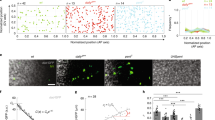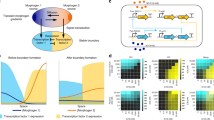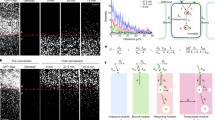Abstract
Morphogens are diffusible signalling molecules that pattern cellular fields by setting up differential gene expression in a concentration-dependent manner. Members of the Wnt family of signalling molecules are generally considered to be classical morphogens. However, a close analysis of their activity indicates that they do not fulfil all of the critera that are associated with the classical definition.
This is a preview of subscription content, access via your institution
Access options
Subscribe to this journal
Receive 12 print issues and online access
$189.00 per year
only $15.75 per issue
Buy this article
- Purchase on Springer Link
- Instant access to full article PDF
Prices may be subject to local taxes which are calculated during checkout



Similar content being viewed by others
References
Wolpert, L. Positional information revisited. Development (suppl.) 107, 3–12 (1989).
Neumann, C. & Cohen, S. M. Morphogens and pattern formation. BioEssays 19, 721–729 (1997).
Gurdon, J. B. & Bourillot, P. -Y. Morphogen gradient interpretation. Nature 413, 797–803 (2001).
Martinez Arias, A. & Stewart, A. Molecular Principles of Animal Development (Oxford Univ. Press, Oxford, 2002).
Nusse, R. & Varmus, H. Wnt genes. Cell 69, 1073–1087 (1992).
Sharma, R. P. & Chopra, V. L. Effects of the wingless (wg1) mutation on wing and haltere development in Drosophila melanogaster. Dev. Biol. 48, 461–465 (1976).
Couso, J. P., Bate, C. M. & Martinez Arias, A. A wingless-dependent polar coordinate system in the imaginal discs of Drosophila. Science 259, 484–489 (1993).
Baker, N. Molecular cloning of sequences from wingless, a segment polarity gene in Drosophila: the spatial distribution of a transcript in embryos. EMBO J. 6, 1765–1774 (1987).
Gonzalez, F., Bejsovec, A., Skaer, H. & Martinez Arias, A. Secretion and movement of the wingless gene product in Drosophila embryos. Mech. Dev. 35, 43–54 (1991).
Stringini, M. & Cohen, S. M. Wingless gradient formation in the Drosophila wing. Curr. Biol. 10, 293–300 (2000).
Bejsovec, A. & Martinez Arias, A. Roles of wingless in the patterning of the epidermis in Drosophila. Development 113, 471–485 (1991).
Baylies, M. K., Martinez Arias, A. & Bate, M. wingless is required for the formation of a subset of muscle founder cells during Drosophila embryogenesis. Development 121, 3829–3837 (1995).
Ingham, P. & Martinez Arias, A. Boundaries and fields in early embryos. Cell 68, 221–235 (1992).
Martinez Arias, A., Baker, N. & Ingham, P. The role of segment polarity genes in the definition and maintenance of cell states in the Drosophila embryo. Development 103, 157–170 (1988).
Di Nardo, S., Sher, E., Heemskerk-Jongens, J., Kassis, J. A. & O'Farrell, P. H. Two tiered regulation of spatially patterned engrailed gene expression during Drosophila embryogenesis. Nature 332, 604–609 (1988).
Payre, F., Vincent, A. & Carreno, S. ovo/svb integrates Wingless and DER pathways to control epidermis differentiation. Nature 400, 271–275 (1999).
Struhl, G. & Basler, K. Organizing activity of wingless protein in Drosophila. Cell 72, 527–540 (1993).
Neumann, C. J. & Cohen, S. M. A hierarchy of cross-regulation involving Notch, wingless, vestigial and cut organizes the dorsal/ventral axis of the Drosophila wing. Development 122, 3477–3485 (1996).
Zecca, M., Basler, K. & Struhl, G. Direct and long range action of a wingless morphogen gradient. Cell 87, 833–844 (1996).
Klein, T. & Martinez Arias, A. Different spatial and temporal interactions between Notch, wingless and vestigial specify proximal and distal pattern elements of the wing in Drosophila. Dev. Biol. 194, 196–212 (1998).
Klein, T. & Martinez Arias, A. The Vestigial gene product provides a molecular context for the interpretation of signals during the development of the wing in Drosophila. Development 126, 913–925 (1999).
Martinez Arias, A. The informational content of gradients of Wnt proteins. Sci. STKE 43, PE1 (2000).
Ng, M., Diaz Benjumea, F. J., Vincent, J. P., Wu, J. & Cohen, S. M. Specification of the wing primordium in Drosophila. Nature 381, 316–319 (1996).
Garcia-Garcia, M. J., Ramain, P., Simpson, P. & Modolell, J. Different contributions of pannier and wingless to the patterning of the dorsal mesothorax of Drosophila. Development 126, 3523–3532 (1999).
Phillips, R. G, Warner, N. L. & Whittle, J. R. Wingless signaling leads to an asymmetric response to decapentaplegic-dependent signaling during sense organ patterning on the notum of Drosophila melanogaster. Dev. Biol. 207, 150–162 (1999).
Couso, J. P., Bishop, S. & Martinez Arias, A. The wingless signalling pathway and the patterning of the wing margin. Development 120, 621–636 (1994).
Martinez Arias, A., Zecchini, V. & Brennan, K. CSL-independent Notch signalling: a checkpoint in cell fate decisions in development? Curr. Opin. Genet. Dev. 12, 524–533 (2002).
Galceran, J., Hsu, S. C. & Grosschedl, R. Rescue of a Wnt mutation by an activated form of LEF-1: regulation of maintenance but not initiation of Brachyury expression. Proc. Natl Acad. Sci. USA 98, 8668–8673 (2001).
Wheeler, J. C., VanderZwan, C., Xu, X., Swantek, D., Tracey, W. D. & Gergen J. P. Distinct in vivo requirements for establishment versus maintenance of transcriptional repression. Nature Genet. 32, 206–210 (2002).
Acknowledgements
I would like to thank M. González Gaitán, O. Grimm and T. Klein for their very useful discussions during the gestation of this piece. My work is funded by The Wellcome Trust, UK.
Author information
Authors and Affiliations
Related links
Related links
DATABASES
LocusLink
FURTHER INFORMATION
Rights and permissions
About this article
Cite this article
Martinez Arias, A. Wnts as morphogens? The view from the wing of Drosophila. Nat Rev Mol Cell Biol 4, 321–325 (2003). https://doi.org/10.1038/nrm1078
Issue Date:
DOI: https://doi.org/10.1038/nrm1078
This article is cited by
-
A systematic review on the effects of acrylamide and bisphenol A on the development of Drosophila melanogaster
Molecular Biology Reports (2022)
-
Genes regulating development and behavior exhibited altered expression in Drosophila melanogaster exposed to bisphenol A: use of real-time quantitative PCR (qRT-PCR) and droplet digital PCR (ddPCR) in genotoxicity study
Environmental Science and Pollution Research (2021)
-
Dynamical states, possibilities and propagation of stress signal
Scientific Reports (2017)
-
Patterning and growth control by membrane-tethered Wingless
Nature (2014)
-
Theoretical and experimental approaches to understand morphogen gradients
Molecular Systems Biology (2008)



